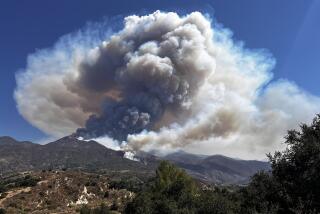Nature Lovers Are Imperiling Nature in Sensitive Areas
- Share via
From rocky tide pools off Dana Point to bubbling mountain streams in the Cleveland National Forest, conservationists in Orange County are struggling to balance two key but conflicting goals: protecting delicate habitats while allowing the public to enjoy them.
Similar problems have bedeviled land management officials across the region.
The San Bernardino National Forest, for example, now receives more visitors than either Yellowstone or Yosemite national parks, a flood of people that has led forest managers to solicit help from private companies to maintain the land.
Development of housing on the fringes of the Mojave National Preserve also has sparked fears of a population surge that could destroy fragile desert ecosystems.
And population pressures in the Santa Monica Mountains have led to widespread concerns about the survival of endangered species in the area’s remaining wild parcels.
But accommodating nature and nature lovers is especially difficult in Orange County, where rapid growth has left only a few expanses of open space--and has created a booming demand for recreation.
The result is that wildlife officials increasingly must make difficult decisions--to limit public access in sensitive ecosystems or face possible habitat disruption that could contribute to the demise of endangered species.
If steps are not taken now to protect existing habitats and set aside dwindling open space in Orange County, environmentalists warn, residents may one day have to leave the county to see unspoiled nature.
“We face a crossroads,” said Warner Chabot, spokesman for the San Francisco office of the national Center for Marine Conservation. “We have a once-in-a-generation opportunity to take dramatic action to restore our coastlines and our landscapes and our marine environment. . . . Whether it’s tide pools, coral reefs or mountains, we’re loving our landscape to death.”
“The more you identify areas as special, the more you attract the public,” Chabot said. “Which often results in more trampling and harm to an area you’re trying to protect. This problem is very acute, especially in Southern California tide pools and shoreline habitat.”
The consequences already can be seen.
At the Dana Point Marine Refuge, fewer hermit crabs are seen because beach goers have taken sea shells that serve as hermit-crab homes. Once abundant sea stars are practically nonexistent in the Dana Point tide pools because of collectors, said Harry Helling, vice president of the Ocean Institute in Dana Point. “The rich community of life that helps define Orange County beaches is really imperiled right now.”
Conservationists and volunteers who monitor the refuge have seen people leaving with buckets full of mussels or garbage bags full of marine snails.
“People feel they have a heritage or a right to take things from beaches,” Helling said. “While that may have been OK 50 or 100 years ago, the fact that we have such a growing population adjacent to these small delicate habitats makes it more incumbent than ever for people to be aware of the correct behavior.”
Officials have taken several steps to stop the destruction of this fragile ecosystem. A coalition of agencies mailed 20,000 brochures titled “Between a Rock and a Hard Place” to tide pool visitors throughout Southern California, spelling out appropriate behavior and alternative marine experiences, such as visiting the Long Beach Aquarium of the Pacific.
Teachers, who bring busloads of schoolchildren to the refuge nearly every day, are instructed about preparing their students for their visits. A recent grant funded training for sheriff’s deputies, who have begun issuing warnings and citations to people who illegally remove marine life from refuges along the coast, Helling said.
In the Cleveland National Forest, the popularity of hiking, picnicking, mountain biking and driving has threatened the endangered Southwestern arroyo toad. U.S. Forest Service officials, concerned with the small toad’s survival, announced earlier this month that two popular Orange County spots beside San Juan Creek will be closed all summer to protect the creature during its breeding season. Maple Springs / Silverado Canyon Road and the Lower San Juan picnic area will be closed from April 1 to Sept. 30.
“It’s difficult in Southern California” to hold back nature lovers when so few areas are available, said Judy Behrens, public service manager with the Trabuco Ranger District in Cleveland National Forest. “We try to balance as best we can to try to provide quality recreational opportunities for folks, but then again protect the delicate habitats and the endangered species.”
A similar closing wasn’t enough at a popular spot in the Angeles National Forest in Los Angeles County. Officials opted for a year-round closure of 3,000 acres around Little Rock Creek after monitoring showed that a smaller, seasonal closing of the camping and fishing area had been ineffective in promoting populations of the Southwestern arroyo toad, said Bill Brown, a U.S. Forest Service biologist with Angeles National Forest.
“We made a lot of people unhappy by taking those kinds of actions,” he said.
Orange County’s population is expected to grow from 2.8 million to 3.3 million by 2020, according to the Center for Demographic Research at Cal State Fullerton. Conservationists expect the growth to strain undeveloped areas.
Dan Silver, coordinator of the Endangered Habitats League, said recreational use can peacefully coincide with preservation in most areas. However, the growing strain on existing resources should prompt officials to acquire the dwindling amount of open space, possibly using money from the parks bond issue passed earlier this month.
Without such steps, “the future will be [that] tide pools are something you see in coffee table books,” Chabot said. “Beautiful pictures of parks will be just that--beautiful pictures--while the parks will be trampled landscapes.”



